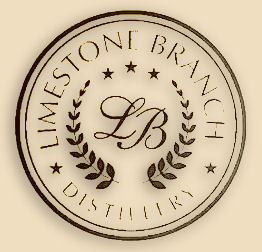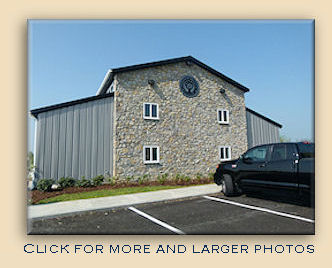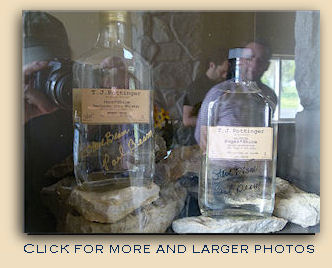American
Whiskey:
April
2,
2012
--
Kentucky's New
Distillers
 Limestone
Branch
Distillery
Limestone
Branch
Distillery
Lebanon,
Kentucky
Well, it looks like those Beams have gone and done it again.
Beginning with Jacob Beam (Boehm) in the early 1700s, members of the Beam family have been either instrumental or at least heavily involved in nearly every successful brand of bourbon whiskey produced in the state of Kentucky (and elsewhere).
It's not quite like a dynasty. The various branches of the family haven't always gotten along all that well with one another, nor have they maintained some kind of feudal "family hold" on the whiskey industry. Far from it; they have often been (and some still are) bitter competitors. But there is something in the blood of the Beam family that involves making corn into alcohol and it lurks there in their genetic makeup.
The legacy of the extended Beam family is far too complex and detailed to go into here, but you can get a very good idea from F. Paul Pacault's very comprehensive study, "American Still Life". Suffice it say, anywhere there is a Beam, there is at least the possibility of a new distillery happening.
And there are more "Beams" than you might imagine. They're all pretty good-lookin' you know; always were. Nearly anyone would jump at a chance to marry into such a family, and often those were the sons and daughters of other powerful distillers. The Dant family would certainly be among such folks.
And here in
2010, Steve and Paul Beam, two brothers who are great-grandsons of both Minor Case Beam and
W. W. Dant, have begun yet another Beam (or would that be Dant?)
distillery, here in the Loretto valley.
Of course, the best-known of the Beam and Dant brands, which came much later, were aged bourbon whiskies, perhaps more the product of the warehousing and merchandising branches of the industry than the actual distilling branch. Much of what individual small distillers made and sold at that time was unaged corn whiskey, or the popular corn-sugar spirit that isn't even allowed to be called "whiskey" under post-Prohibition laws. Of course, that doesn't make such products not good, as many an artisan distiller will be proud to demonstrate for you. There are, in fact, some perhaps overly suspicious persons who might hint that at least one purpose of the federal aging laws of the '30s was to ensure that those distilleries who already had existing government licenses for marketing aged whiskey would not be threatened by new-whiskey producers when the Prohibition laws were repealed.
Yes, that sort of thing was not unheard of.
Steve and Paul will probably market aged whiskey in a few years. Everyone does; it seems you can't be taken seriously if you don't. But for the time being they have exactly two products, and neither is aged.
Well, that
not might not be exactly true; at least for some distillers of "white whiskey".
It seems the Federal Code of Regulations requires that you must age your
distillate in oak wood if you want to call it "whiskey". They do not specify how
long; in other words, if it touches wood somewhere along the way from the still
to the bottle, that's good enough. So, technically, both of the Limestone Branch
products could be called "whiskey" if they so much as spilled the spirit through
an oak trough on its way to the bottling line. Yes, there are distillers that
actually do that, and so what? Anyway, Limestone Branch proudly does NOT use the
word "whiskey" on their label, and for that we salute them.
They also don't use "Limestone Branch" as their actual brand name. Both of their current products, a true corn whiskey and a just-as-true "moonshine-type" whiskey that they call 50-50-50 because it's 50% corn, 50% sugar, and 50% alcohol (100-proof), are branded T. J. Pottinger. That was the whiskey made by Great-Grampa Beam. He also produced Old Trump, which they are not (currently) marketing, and which we suspect will be the name they give to their aged whiskey when it's ready to release. They can't, unfortunately, use the Dant name, as that is now owned by at least one other distilling company.
Limestone's operation is very simple. In fact, except for some rather expensive cooling equipment, it is almost scarily simply. You've almost certainly seen the "How Moonshine is Made"-type documentaries on television. Well, it's almost that simple. Except, of course, that every step is carefully documented and recorded, and every step is certified to be clean and non-lethal (not the case with illegal moonshine stills, of course). And the product is only acceptable if it meets first-rate standards. We've often stated that regular moonshine customers get the cheapest raw alcohol we can produce; if you want the really GOOD stuff, you have to be invited to the wedding. Well, both T. J. Pottinger products are suitable for the wedding guests, and that's a fact.
We are only beginning to look at America's new small distilleries, so it's hard to say who's going to be successful and who isn't. With a background like Steve and Paul's, we think this one has a chance. Will you get to try this whiskey without coming to Kentucky? Well, I don't know, and maybe that's reason enough to come visit this wonderful state. But yes, we think you'll have a chance to buy T. J. Pottinger whiskey (or "spirit" since they have the integrity to use that term) in your local liquor store eventually.
Our suggestion is to do so, and then re-read this article while sipping some.
 |
|
|
Story and original photography
© 2012 by John F. Lipman. All rights reserved. |
|

